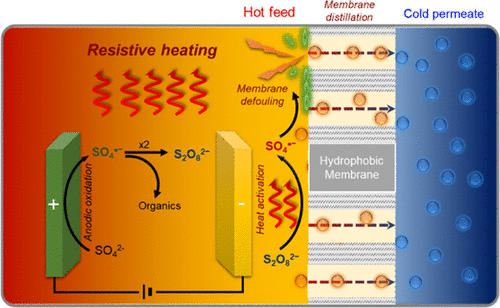当前位置:
X-MOL 学术
›
Environ. Sci. Technol.
›
论文详情
Our official English website, www.x-mol.net, welcomes your feedback! (Note: you will need to create a separate account there.)
Electrochemical Oxidation-Membrane Distillation Hybrid Process: Utilizing Electric Resistance Heating for Distillation and Membrane Defouling through Thermal Activation of Anodically Formed Persulfate.
Environmental Science & Technology ( IF 11.4 ) Pub Date : 2020-01-24 , DOI: 10.1021/acs.est.9b05141 Yong-Uk Shin 1 , Eun-Tae Yun 1 , Junghyun Kim 1 , Hongshin Lee 1 , Seungkwan Hong 1 , Jaesang Lee 1, 2
Environmental Science & Technology ( IF 11.4 ) Pub Date : 2020-01-24 , DOI: 10.1021/acs.est.9b05141 Yong-Uk Shin 1 , Eun-Tae Yun 1 , Junghyun Kim 1 , Hongshin Lee 1 , Seungkwan Hong 1 , Jaesang Lee 1, 2
Affiliation

|
This study reports distillation-based salt removal by Ohmic heating in a hybrid process, in which electrochemical oxidation (EO) and direct contact membrane distillation (DCMD) are performed sequentially. In addition to anodically destructing the organics, the hybrid process also separated the sulfate-based electrolytes from treated water through distillation, without consuming external energy, owing to the temperature of the aqueous sulfate solution being elevated to 70 °C via resistive heating. The hybrid process treated organic compounds in a nonselective fashion, whereas DCMD alone did not completely reject (semi)volatile organics. Integrating EO with DCMD made the hybrid process resistant toward the wetting phenomenon; the process exhibited a steady distillate flux and salt rejection as the initial loading of amphiphilic sodium dodecyl sulfate was increased to 0.3 mM. Anodic persulfate formation from the sulfate and Ohmic heating caused an in situ yield of the sulfate radical in the feed solution; this eliminated membrane fouling, according to the observation that the water flux, which was drastically reduced upon adding alginate, was recovered immediately after an electric current was applied. The hybrid process concurrently decomposed spiked organics and removed naturally present inorganic ions in actual flue gas desulfurization wastewater, without an external supply of electrolyte and heat energy.
中文翻译:

电化学氧化-膜蒸馏混合工艺:利用电阻加热通过阳极形成的过硫酸盐的热活化进行蒸馏和膜脱污。
这项研究报告了通过混合加热过程中的欧姆加热去除基于蒸馏的盐,其中依次进行电化学氧化(EO)和直接接触膜蒸馏(DCMD)。除了阳极破坏有机物外,混合工艺还通过蒸馏从处理过的水中分离出硫酸盐基电解质,而无需消耗外部能量,这是由于通过电阻加热将硫酸盐水溶液的温度提高到70°C。混合工艺以非选择性方式处理有机化合物,而单独的DCMD并不能完全排斥(半)挥发性有机物。EO与DCMD的集成使混合工艺能够抵抗润湿现象。该过程显示出稳定的馏出液通量和脱盐率,因为两亲十二烷基硫酸钠的初始载量增加到0.3 mM。由硫酸盐和欧姆加热形成的阳极过硫酸盐导致进料溶液中硫酸盐基团的原位收率。这种观察结果消除了膜的结垢,这是由于观察到的结果是,在施加电流后立即恢复了因添加藻酸盐而急剧减少的水通量。混合过程同时分解了加标的有机物,并去除了实际烟道气脱硫废水中的天然存在的无机离子,而无需外部供应电解质和热能。这种观察结果消除了膜的结垢,这是由于观察到的结果是,在施加电流后立即恢复了因添加藻酸盐而急剧减少的水通量。混合过程同时分解了加标的有机物,并去除了实际烟道气脱硫废水中的天然存在的无机离子,而无需外部供应电解质和热能。这种观察结果消除了膜的结垢,这是由于观察到的结果是,在施加电流后立即恢复了因添加藻酸盐而急剧减少的水通量。混合过程同时分解了加标的有机物,并去除了实际烟道气脱硫废水中的天然存在的无机离子,而无需外部供应电解质和热能。
更新日期:2020-01-26
中文翻译:

电化学氧化-膜蒸馏混合工艺:利用电阻加热通过阳极形成的过硫酸盐的热活化进行蒸馏和膜脱污。
这项研究报告了通过混合加热过程中的欧姆加热去除基于蒸馏的盐,其中依次进行电化学氧化(EO)和直接接触膜蒸馏(DCMD)。除了阳极破坏有机物外,混合工艺还通过蒸馏从处理过的水中分离出硫酸盐基电解质,而无需消耗外部能量,这是由于通过电阻加热将硫酸盐水溶液的温度提高到70°C。混合工艺以非选择性方式处理有机化合物,而单独的DCMD并不能完全排斥(半)挥发性有机物。EO与DCMD的集成使混合工艺能够抵抗润湿现象。该过程显示出稳定的馏出液通量和脱盐率,因为两亲十二烷基硫酸钠的初始载量增加到0.3 mM。由硫酸盐和欧姆加热形成的阳极过硫酸盐导致进料溶液中硫酸盐基团的原位收率。这种观察结果消除了膜的结垢,这是由于观察到的结果是,在施加电流后立即恢复了因添加藻酸盐而急剧减少的水通量。混合过程同时分解了加标的有机物,并去除了实际烟道气脱硫废水中的天然存在的无机离子,而无需外部供应电解质和热能。这种观察结果消除了膜的结垢,这是由于观察到的结果是,在施加电流后立即恢复了因添加藻酸盐而急剧减少的水通量。混合过程同时分解了加标的有机物,并去除了实际烟道气脱硫废水中的天然存在的无机离子,而无需外部供应电解质和热能。这种观察结果消除了膜的结垢,这是由于观察到的结果是,在施加电流后立即恢复了因添加藻酸盐而急剧减少的水通量。混合过程同时分解了加标的有机物,并去除了实际烟道气脱硫废水中的天然存在的无机离子,而无需外部供应电解质和热能。


























 京公网安备 11010802027423号
京公网安备 11010802027423号